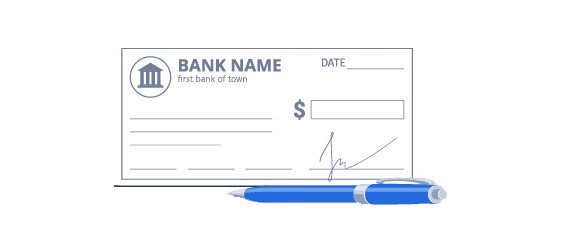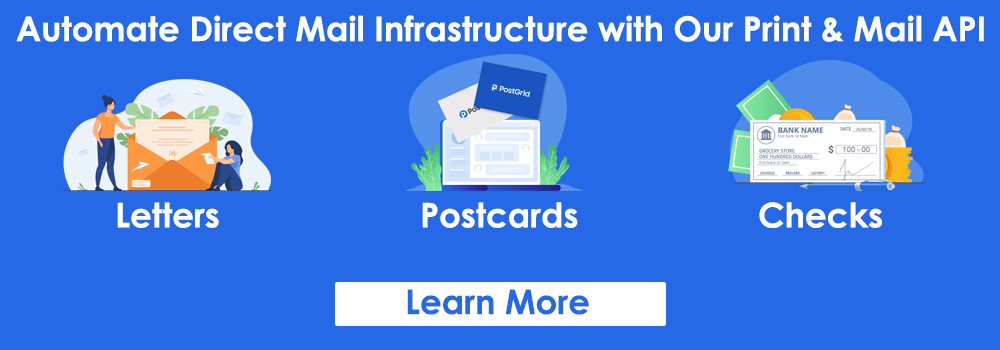Endorsing a Cheque in Canada
Endorsing a Cheque in Canada
The endorsement of cheques serves a specific set of purposes, and the process of endorsing a cheque can vary from one country to another. In Canada, the endorsement of a cheque is pretty straightforward. You may have noticed that we endorse the cheque by signing on the back whenever we cash or deposit it into our account.
Have you ever wondered why we do that?

What is the point of signing the back of a cheque? Is it mandatory to do so?
If the cheque is a personal one and you are present in person at the bank when it is processed, a simple endorsement like the one above is good enough. However, businesses should take the endorsement of cheques more seriously.
Below we discuss the salient features of cheque endorsements and why it is vital for businesses to use them. Furthermore, we will also give answers to all the questions stated above. So, if you own or run a business and want to know more about cheque endorsement, you should keep on reading.
What Does It Mean To Endorse A Cheque?
After a person or business receives a cheque, it is a standard practice to sign the back of the cheque. Endorsing a cheque is the process of signing the back of the cheque before depositing or cashing it. Another aspect to note here is that endorsement of cheques can be different for different countries.
Some countries only require you to provide the date and name as part of their cheque endorsement whereas others may require more detailed information. Luckily, endorsing a cheque in Canada is pretty simple. All you need to do is sign the back of the cheque. The chances are that the cheque will have a marking where the payee can put the sign.
Endorsing the cheque enables the bank to process the cheques efficiently and also helps to protect them from fraud. As you know, the most critical part of the endorsement of a cheque in Canada is the signature. However, you can dictate the bank’s payment processing method to add more layers of security and minimize the chances of fraud.
Different Way To Endorse A Cheque
There are different ways in which you can endorse a bank cheque. The recipient of a cheque can choose which type of endorsement they want to use so that the bank can process it efficiently. Some of the most common ways to endorse a cheque in Canada include the following.
Blank Endorsement
Contrary to what the name suggests, the blank endorsements are not “blank” at all. Blank endorsements mean that you don’t need to provide any additional information on the back of the cheque other than your signature.
As you can guess, blank endorsements are the most straightforward form of endorsement of cheques. However, it is also risky to use blank endorsement. Here, the payee does not provide any instruction to the bank, and all they have is your sign on the cheque.
Hence, it is best to use blank endorsement only if the payee intends to immediately deposit or cash the cheque. If you are physically present in the bank and want to deposit it in your account, a blank endorsement is more than enough. But, if someone else is cashing the cheque for you, then a blank endorsement may not be your best option.
Restrictive Endorsement
Most businesses choose to have their cheque deposited directly into their account. For such cheques, you can add the phrase “For deposit only” along with the signature. This type of endorsement is called a restrictive endorsement.
You can even specify the bank account you want to deposit the cheque. However, you need to provide the account number with the endorsement of the cheque. The account number is in addition to the written instruction, which means providing the account number alone is not enough.
Write “For deposit only to *account number*” along with the endorsement. Doing so can significantly reduce the chance of an error of fraud in cheque transactions. It is also worth noting that you may not have to sign if the account number is already on the cheque. But this can change depending on specific circumstances.
Full Endorsement
The endorsement in full is a cheque endorsement you can use if you want to sign over the cheque to someone else. Suppose the name of the person you want to hand over the cheque to is Tony Stark.
In this case, your endorsement should include the phrase “Pay to the order of Tony Stark.” However, you may have to appear in person with the depositor if you use a full endorsement on a Canadian cheque. Furthermore, some banks do not allow this type of endorsement of cheques because of the risk involved.
Hence, it is best to call the bank before using this type of endorsement of cheques.
No Endorsement
Endorsements can enhance the security of cheque transactions and speed up the transaction. However, it is not mandatory to provide endorsement of cheques for every transaction. Many banks let their customers deposit cheques without endorsing a cheque with an account number, signature, etc.
Using no endorsement on your cheques is not advisable. However, it does have some upsides to it. For instance, no endorsement is ideal if you want to keep all your information private. No endorsement is an effective way to protect your bank account number, signature, etc., which others can use for fraudulent activities.
It would be best to remember that the banks are reluctant to cash in cheques with no endorsements. A better idea than providing no endorsement would be to deposit the cheque directly into the bank account. You can also write “for deposit only” to streamline the process.
How to Endorse a Cheque
When endorsing a cheque in Canada, the first thing you need to do is flip the cheque and examine its backside. You will observe that the back of a Canadian cheque is primarily blank and does not contain any crucial information.
Positioning The Signature For The Endorsement
No one can access vital information such as the account holder’s name or even the cheque amount from the backside of a cheque. However, you can locate a signature line marked on the back of the cheque. Most cheques will at least have a single line on their backside.
Some cheques also include an x mark on the line, where the payee needs to put their signature. However, it is possible to not find or see the line on the backside. In that case, you can sign on the side of the cheque away from the part where they write the account holder’s address. The position of the signature is closest to the date on the front of the bank cheque.
Pay Special Attention To The Payee’s Name/Sign
One of the most crucial aspects to ensure that the endorsement of the cheque is proper is the payee’s name. Make sure that the name/sign of the payee on the front of the cheque matches perfectly with the name/sign on the endorsement.
Suppose you make a mistake and misspell the name. In that case, you need to mark and sign the incorrect version. You would also need to provide the correct name of the payee after signing the wrong one. However, make sure that you give the endorsement in its designated area.
Different Types Of Cheques And Who Needs To Endorse Them
Even businesses that often send and receive cheque payments are sometimes confused about signing the endorsement. The endorsement of cheques is done by the recipient (or payee) of the cheque.
As we know, the person who writes the cheque already puts their signature on the front of the cheque. There is no need for them to sign on the back of the cheque either. Some cheques address more than one person and it is confusing to figure out how to endorse a cheque.
Below we discuss some of these exceptional cases and how you can endorse them.
Cheques Addressed To More Than One Person
Sometimes bank cheques are addressed to more than one person. If that is the case, the payees might be concerned about signing a cheque for endorsement.
Should all the recipients sign the endorsement? Or is just a single signature enough?
The answer to this question can vary depending on how the writer of the cheque addressed the recipients in the cheque. Suppose, the cheque writer adds” and” between the two names on a cheque. In this case, the endorsement would need the signature of both parties.
Business Cheques
The endorsing process for business cheques is not the same as a personal cheque. As you can guess, the main reason for this is that business cheques are not for individuals but for businesses. Hence an individual can not endorse the cheque.
You must understand that according to the law, businesses are separate entities. It is possible to prosecute an entire business as it operates independently of the person who owns it. However, an individual can endorse the cheque on behalf of the business.
An individual can endorse a business cheque only if they have the requisite authorization for doing it. When it comes to business cheques, you need an authorized person to sign them, and this is not just limited to endorsements.
FBO Cheques
The FBO in FBO cheques stands for “for the benefit of.” So, if you see the letters FBO on a cheque, it means that the cheque is for a third party. Hence, the first or initial payee must endorse the cheque first.
To help you better understand the endorsement of FBO cheques, let’s consider an example. Suppose the FBO cheque says, “Mrs. Kent FBO Mr. Kent.” In this case, the first person to endorse the cheque should be Mrs. Kent. Mr. Kent can then follow the endorsement with his signature.
Retirement account custodians often receive FBO cheques for rollover transactions. Usually, the custodian handles the transaction of such cheques, and they don’t usually need to be endorsed.
Why Is Endorsement Of Cheque Important?
There are numerous advantages of using the endorsement of cheques. Legally speaking, only the person to whom the sender writes the cheque can cash in cheque payments. The best and most convenient way to process a cheque payment is to go to the bank.
Faster Processing Of Cheques
One of the most significant advantages of endorsing your bank cheque is that it makes cheque processing much faster. The endorsement on the cheques enables the bank to cross-check the information and deposit the money into your account.
Safer Cheque Transactions
Cheque transactions are prone to delays if the bank thinks something is off about the transactions. The bank may allow you to deposit the cheque without endorsement. But, there is a chance for the banks to put the cheque on hold.
If the bank suspects an error or fraud in the cheque transaction, the bank could freeze the fund until everything is sorted. Providing endorsement on the cheque can minimize running into such problems with cheque transactions.
Note: when you endorse a cheque, it is best to wait as long as you can before signing it. Ideally, you should only sign the cheque once you reach the bank or right before making a mobile deposit. Doing so reduces the chance of someone else stealing the cheque and depositing it in their account.
Using PostGrid To Ensure Smooth Cheque Transactions
The accuracy of cheque transactions is more dependent on the sender than the recipient. Using PostGrid, businesses can ensure that their cheques are printed and mailed accurately to their recipients. The automated system provides that there is zero error in cheque printing.
With the super accurate cheque printing offered by Postgrid, the only thing that can delay cheque payments is the endorsement or the lack of it. However, you can use PostGrid to provide accurate and clear markings for the endorsement of cheques.
Hence, PostGrid effectively minimizes the chance of an error in cheque payment. Suppose the recipients of the cheque are also careful about their endorsements. In that case, businesses can achieve a streamlined cheque payment process.
Conclusion
Endorsing a cheque in Canada is the safest way to ensure that the bank processes your cheque payments without delay. Businesses that primarily depend on cheque payments for their transactions should ensure that their cheques are error-free.
Using an automated solution like PostGrid is the best way to ensure that the cheques you send are error-free. PostGrid uses a computerized print and mail system to print cheques without a single error.
Furthermore, PostGrid also lets you print clear and crisp markings for providing the endorsement. Therefore, as long as the recipient of your cheque writes their cheque endorsement correctly, there is no chance for delayed payments.
The post Endorsing a Cheque in Canada appeared first on PostGrid.
source https://www.postgrid.ca/endorsing-a-cheque-in-canada/




Comments
Post a Comment